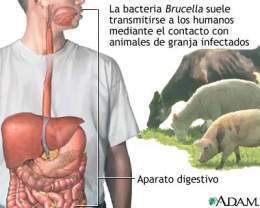Brucellosis is an infectious zoonosis caused by one of four Brucella species or biovars known to infect humans: Brucella mellitensis (goats and sheep), B. abortus (cattle), B. suis (pigs), and B. canis ( dogs). B. neotomae (rodents) and B. ovis (sheep) cause infections in animals, but have not been transmitted to humans. In the pediatric population, infection occurs by direct contact, by inhalation of aerosols, and by ingestion of unhygienized milk or milk products from infected animals. Efforts to control the disease in domestic animals and pasteurization of milk have markedly reduced the incidence of infection in industrialized countries, but sporadic outbreaks occur, and the disease remains endemic in wild animals. The clinical presentation in children is similar to that in adults. Only about 50% of cases present with acute disease; the rest have subclinical or subacute infections.

Etiology
They are small, aerobic, non- sporulated immobile gram – negative rods lacking a visible capsule. They are fastidious, and some variants grow best in a CO2-rich atmosphere.
epidemiology
In industrialized countries, the usual route of infection is occupational or recreational exposure to infected animals. Direct contact and exposure to aerosols of infected tissues has been documented in slaughterhouse workers, veterinarians, farmers, hunters and others with frequent contact with animals. Endemic brucellosis is usually transmitted by ingestion of unpasteurized milk, cream, butter, cheese, or ice cream. The germ can directly invade the eye, nasopharynx, and genital tract. The germs can remain viable for up to 3 weeks in a refrigerated animal carcass and can survive the curing of the ham. Mandatory milk pasteurization, vaccination of cattle, and other control measures have markedly reduced endemic disease.
Clinical manifestations
In the absence of a history of exposure to animals or ingestion of unpasteurized milk, the clinical diagnosis of brucellosis in children is difficult. The most frequent are nonspecific manifestations of fever, arthralgia, malaise, weakness and manifestations of the central nervous system, especially depression. Incubation periods of between a few days and several months have been described. The interval between the onset of symptoms and diagnosis lasts up to 150 days, with an average of 4 weeks. Hepatomegaly and splenomegaly are found in 30-40% of cases. Organ-specific forms such as osteomyelitis, myocarditis, endocarditis, and genitourinary tract infections are rare. Bone scan is more sensitive than x-ray in detecting skeletal brucellosis.
Diagnosis
– The medical history may suggest brucellosis, especially if there is exposure to animals or ingestion of unpasteurized milk or dairy products. Anemia, hemolysis, leukopenia, thrombocytopenia – pancytopenia due to hypersplenism, hemophagocytosis have been describedand bone marrow involvement. – Blood cultures are positive in up to 75% of acutely ill patients if they have not received antibiotics. Isolation in blood culture is much less common in subacute disease. It is important to notify the laboratory of suspected brucellosis, since blood cultures should be maintained for up to 4 weeks, and routine blood cultures are only maintained for 7-10 days. – In the absence of a culture diagnosis, serological diagnosis is possible. The standard tube agglutination test is used. IgM antibodies are measured by a reduction in titer after treatment with 2-mercaptoethanol (2-ME). IgM antibodies appear early in infection, followed 1-2 weeks later by IgG antibodies. High titers of IgG antibodies or a rising titer after treatment suggest the presence of persistent or recurrent infection. – Results have been observed with the test ofenzyme immunoassay .
Differential diagnosis
– Tularemia. – Typhoid fever. – Rickettsiosis. – The flu. – Tuberculosis. – Histoplasmosis. – Coccidiodomicosis. – Infectious mononucleosis. – Malignant histiocytosis. – Lymphoma.
Treatment
– Tetracycline in combination therapy is the treatment of choice for brucellosis. Doxycycline in a dose of 5 mg / kg / 24 h (maximum 200 mg / 24 h), administered orally in two doses with intramuscular streptomycin (30 mg / kg / 24 h) divided every 12 h or gentamicin IV (5- 7.5 mg / kg / 24 h), divided every 8 hours, is a frequently used regimen. Due to the problems posed by tetracyclines in children under 10 years of age and the need for intramuscular or intravenous administration of aminoglycosides, alternative regimens have been considered. – The combination of two oral drugs, trimethoprim-sulfamethoxazole (10-12 mg / kg trimethoprim) with rifampicin (15-20 mg / kg), was effective. – Therapeutic failures with beta-lactams, Among them, 3rd generation cephalosporins such as ceftriaxone, may be due to the intracellular nature of the pathogen and the presence, in subacute or persistent infections, of cells that do not divide. The total duration of treatment is usually 3 to 6 weeks. The initiation of treatment when there has been a delay in diagnosis may be accompanied by a reaction similar to that of Jarisch-Herxheimer described in syphilis, presumably because of the large antigenic load. When this reaction is seen steroids can be given, if necessary. The initiation of treatment when there has been a delay in diagnosis may be accompanied by a reaction similar to that of Jarisch-Herxheimer described in syphilis, presumably because of the large antigenic load. When this reaction is seen steroids can be given, if necessary. The initiation of treatment when there has been a delay in diagnosis may be accompanied by a reaction similar to that of Jarisch-Herxheimer described in syphilis, presumably because of the large antigenic load. When this reaction is seen steroids can be given, if necessary.
